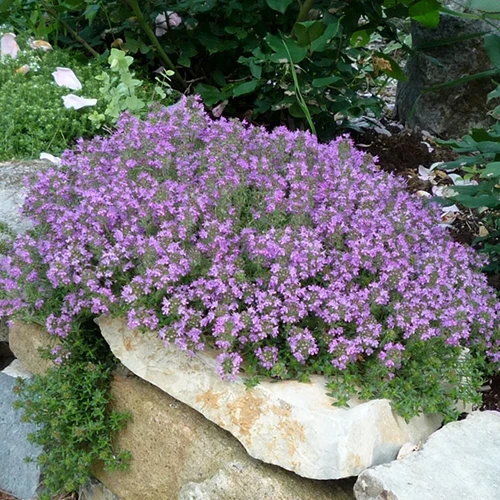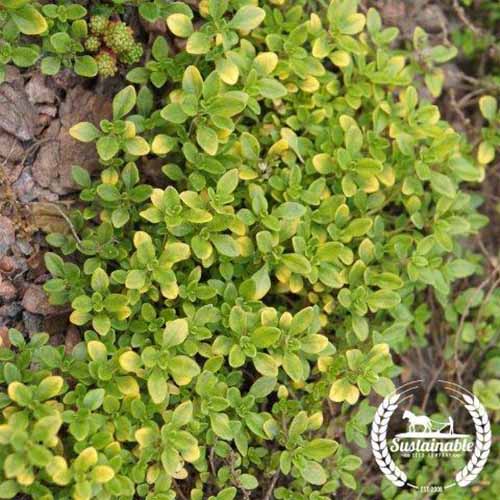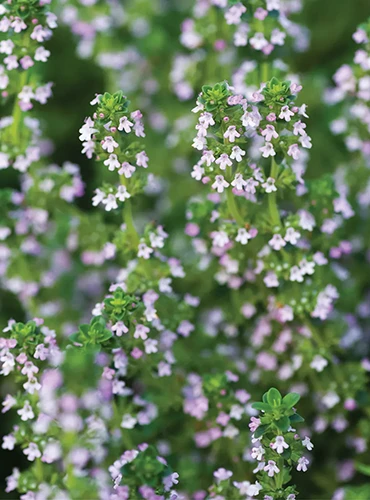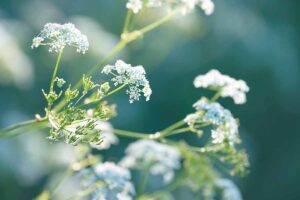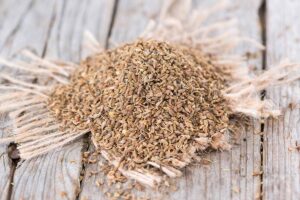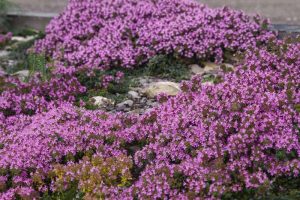Almost as iconic on your kitchen shelf as salt and pepper, thyme is a pillar of any good herb pantry.
By itself or combined with other aromatic herbs, you will always be happy to have thyme at your fingertips. And the famous folk ballad “Scarborough Fair” wouldn’t be complete without it.
Characterized by an aromatic smell, distinct flavors, and small green leaves, this herb is a linchpin culinary ingredient while its dainty flowering style dresses up a garden.
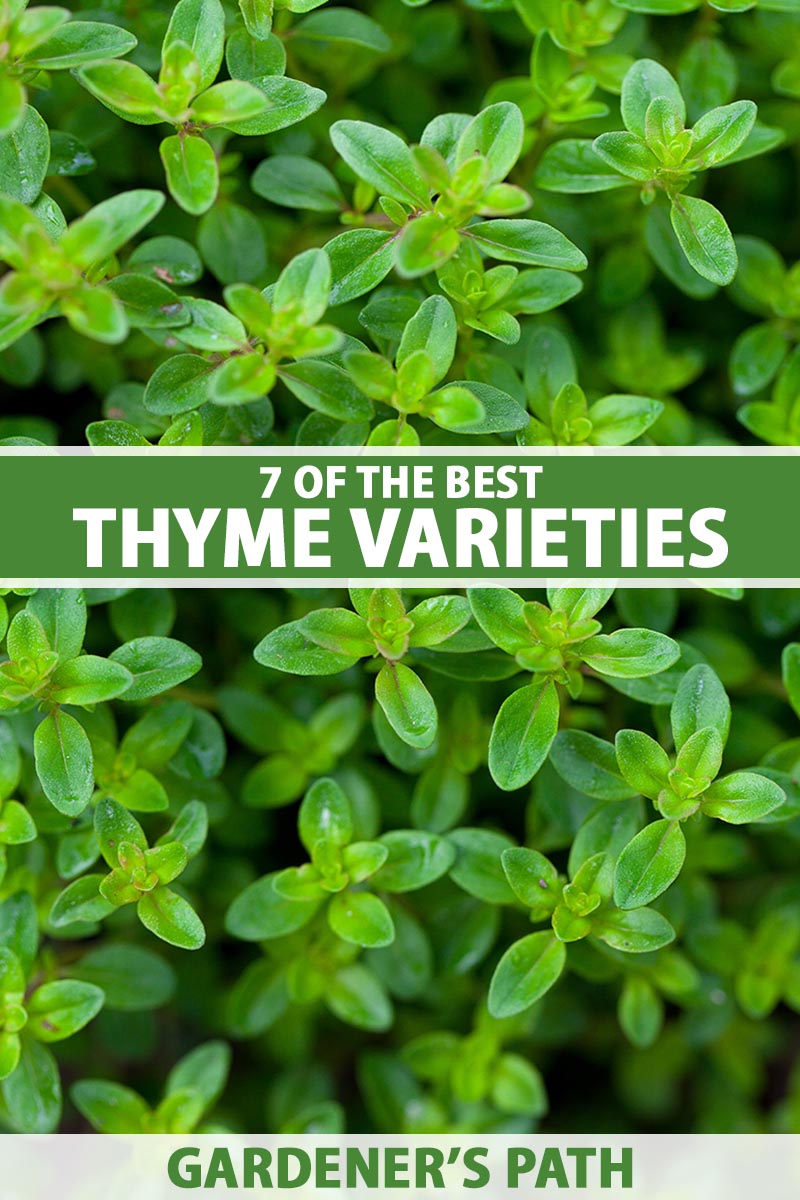
We link to vendors to help you find relevant products. If you buy from one of our links, we may earn a commission.
Members of the genus Thymus, these plants hail from the mint family, Lamiaceae.
Indigenous to the Mediterranean area of Europe and evergreen in regions with mild weather, there are many species and cultivars, some ornamental and others edible.
A mainstay in cooking, thyme is also an ally in the herbal medicine cabinet.
Thymol, a phenol responsible for its strong flavor, also has antioxidant and antifungal properties, and supports a strong immune system. Keeping a tincture at home is smart natural wellness practice.
Plant this herb outdoors in Zones 5 to 9 in the spring and grow it in full sun.
Drought tolerant, this perennial plant grows steadily, rewarding the gardener with abundant harvests. Prune it back every fall to keep it from getting woody, and don’t overwater.
Thyme can also be grown indoors in six-inch or larger pots. Keep them in a sunny window and sprigs will supply your kitchen throughout the year.
Here are seven excellent options to add to your herb garden this season:
1. Caraway
T. herba-barona, or caraway thyme, is an edible and ornamental species.
Native to the Mediterranean islands of Corsica, Sardinia, and Majorca, this herb smells like caraway, thanks to the carvone terpenoids it contains.

The leaves are long pointed ovals, dark green and glossy, on reddish stems. In late spring through summer, T. herba-barona produces pink flowers, charming local butterflies and bees with its rich nectar.
This low-growing, creeping species attains a height of only about four inches and spreads to create large mats. It’s a landscaper’s dream for filling in the spaces between stones and raised beds.
2. Creeping
T. serpyllum, or creeping thyme, is a subshrub that only grows to one inch high with stems reaching up to four inches long.
Also known as Breckland, wild, and elfin thyme, this mat-forming species creeps along the ground.
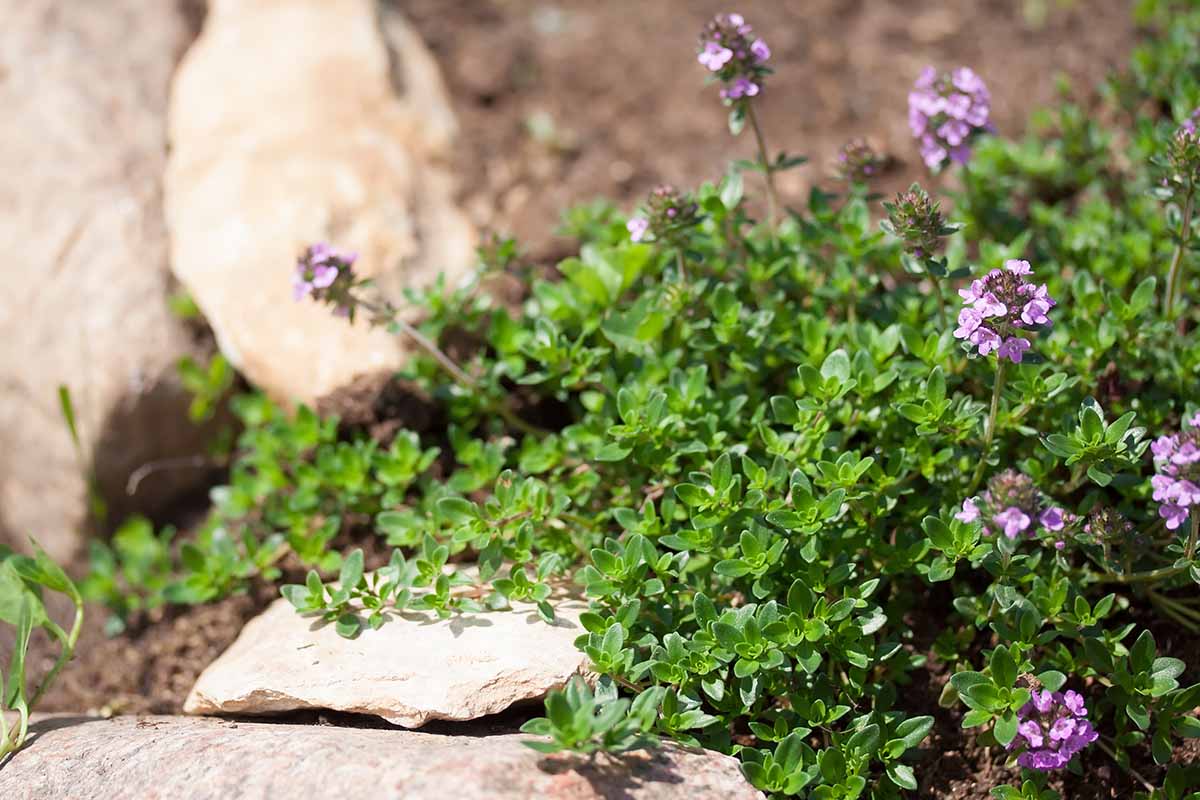
An ornamental, this species is strongly aromatic with an herbal citrus scent. Its wee oval green leaves grow in opposite pairs on each stem, and flowers are produced in itty-bitty clusters of lilac, pinkish-purple, magenta, or more rarely, white blooms.
Creeping thyme can serve many purposes in the garden. Its form makes it a fantastic ground cover. The low branches create filler between stones, and its wild habit allows it to sprawl over rocks as well.
Flowering takes place from July through August, and you’ll be sure to see the honeybees visiting to feed on their nectar.
Seeds are available in an assortment of sizes ranging from small packets to one-pound packages at Eden Brothers.
Learn more about how to grow creeping thyme as aromatic ground cover in our guide.
3. Garden
The most popular species is garden thyme, T. vulgaris, also called common, English, and French.
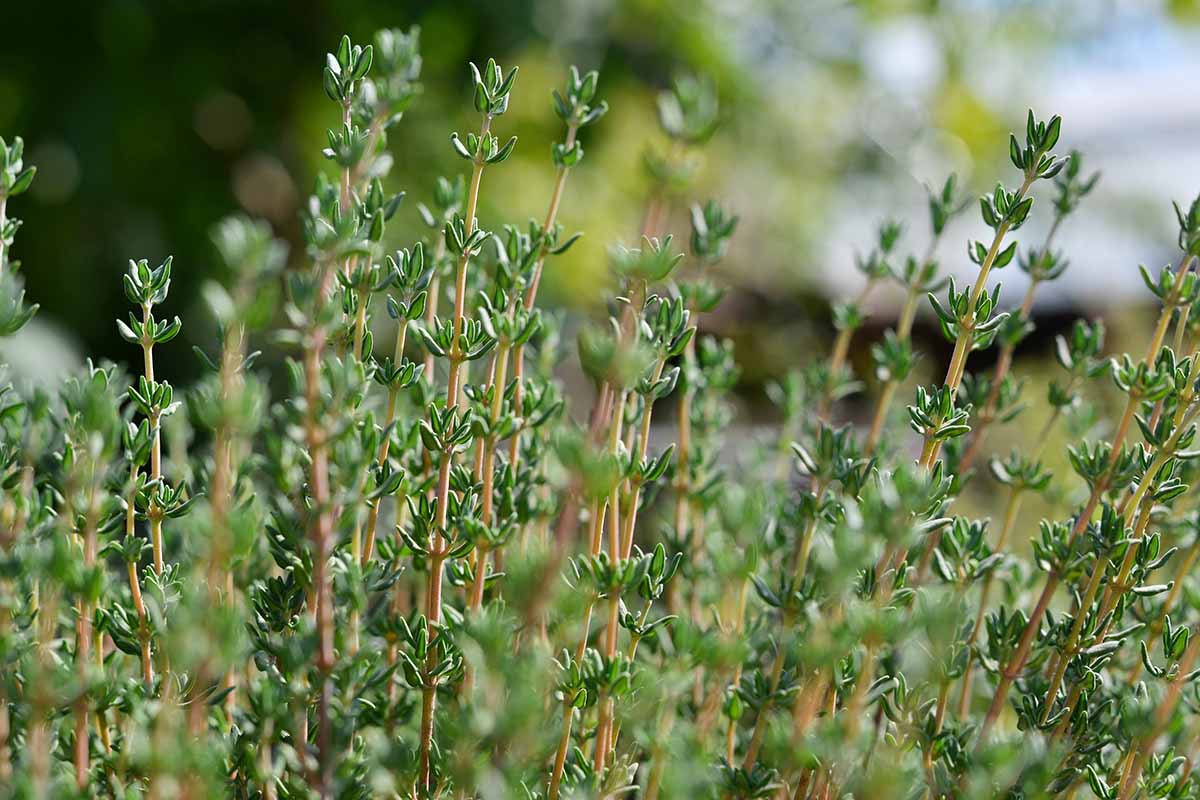
An edible dwarf flowering plant with whorled tiny grayish-green leaves and pink tube-like flowers, the bushy herb can grow up to 12 inches high and up to 16 inches wide.
Just rub the leaves to smell the spicy fragrance. You’ll get the best of this herb in terms of flavor if you harvest the leaves right before flowering.
Use scissors or pruners to cut off sprigs, which are the small branches full of leaves.
Fresh and dried thyme are delicious additions to vegetable, meat, or fish dishes.
Find 500-milligram seed packets available at True Leaf Market.
Looking for live plants instead? These are available at Burpee.
Learn how to grow common thyme in our guide.
4. Juniper
T. leucotrichus, the juniper variety, is a perennial herb with hairy, bluish-green leaves.
Their silvery needle-like appearance growing off the stem inspired another common name for this type: moonlight.
Small, pink flowers bloom from early to midsummer. Edible and ornamental, this species has a sharp and spicy flavor and scent – be sure to use it a bit more sparingly than you might common thyme, and taste as you go.
This species is native to Greece and Turkey, and it appreciates full sun exposure. With a height of six to eight inches and a spread of six to 12 inches, its small size is perfect for containers, and it can also be used as a ground cover.
Exceptional form as a decorative garden accent and broad culinary use make juniper an attractive variety to grow at home.
5. Lemon
A lemon-scented species, T. citriodorus is a small shrub that blooms with whorls of pink and lavender flowers in mid- to late summer.
This variety’s tiny oval green leaves grow in opposite pairs on its thin stems, and feature a unique pale yellow border that makes each sprig an attractive garnish.
Sometimes called citrus thyme, this species is often grown as a decorative ornamental, but it is also edible and may be used in cooking and in medicine.
The leaves are eaten raw, dried for teas, used to flavor oil, and muddled for beverages.
We love this variety for its scent, and neighborhood bees and butterflies adore it for its nectar.
‘Lime’ and ‘Orange’ cultivars are highly sought after for use in aromatherapy. It grows about six to 12 inches tall and spreads 12 to 18 inches.
Lemon thyme has a mat-like growth habit, with a compact root system.
A terrific ground cover, border, or edging ornamental, it can tolerate some light foot traffic, releasing that wonderful fragrance if it’s stepped on.
Burpee carries seedlings in mix-and-match sets of three plants.
Packages of 1,000 seeds are available on Amazon.
Check out our guide to learn more about lemon thyme.
6. Mother of Thyme
T. praecox is an evergreen edible and ornamental shrub.
Also known as wild or creeping thyme, the mini green leaves grow in opposite pairs of organized clumps along the stems, and flowers bloom in teensy purple bunches in the summer.

This species loves full sun and has a strong scent similar to oregano.
Harvest the leaves and flowers for cooking, or let the plant grow into an alluring aromatic ground cover for your yard. It reaches a height of one to two inches with a spread of 12 to 18 inches.
7. Wooly
Formerly known as T. psuedolanuginosus and reclassified as T. praecox subsp. britannicus, wooly thyme is a low-growing, spreading plant with hairy leaves and stems.
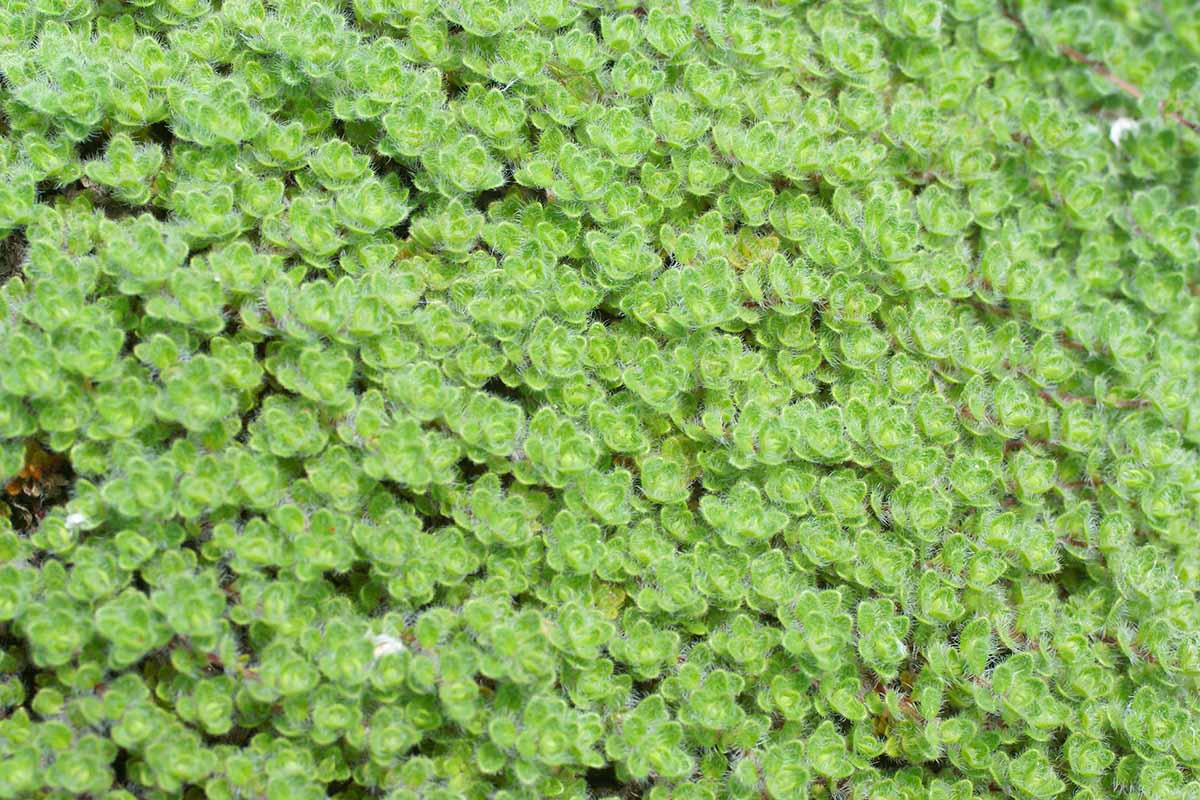
The white hairs that sparsely cover the surface give a surreal and soft furry aesthetic to this ornamental.
The wooly species grows in dense cushions of broad mats and in early summer, pale pink flowers bloom. The fuzziness factor fashions an ideal, almost carpet-like ground cover.
This species can grow up to three inches high and its stems can branch out to push the plant 12 inches wide.
This variety is not as fragrant as others, and finds its best function in beds, borders, and rock gardens.
Thyme to Choose At Least One to Grow
You owe it to your dinner guests to grow an exquisite edible thyme, and you owe it to yourself to decorate your yard with an elegant ornamental.

Once you have harvested the fresh herb from your kitchen garden and added it into an incredible meal, you can spend time with an after-dinner cocktail amongst the beautiful-smelling thyme carpeting your gorgeous landscape.
Make your night complete by watching the feature film, “The Graduate,” starring a young Dustin Hoffman.
You can play a drinking game and count how many times you hear your new garden herb mentioned in Simon and Garfunkel’s rendition of the famous aforementioned song, which dominates memorable scenes in the movie.
Of course, that drink could have muddled thyme in it too…
What’s your favorite variety? Let us know in the comments section below!
And to learn more about growing herbs, check out these helpful guides next:
